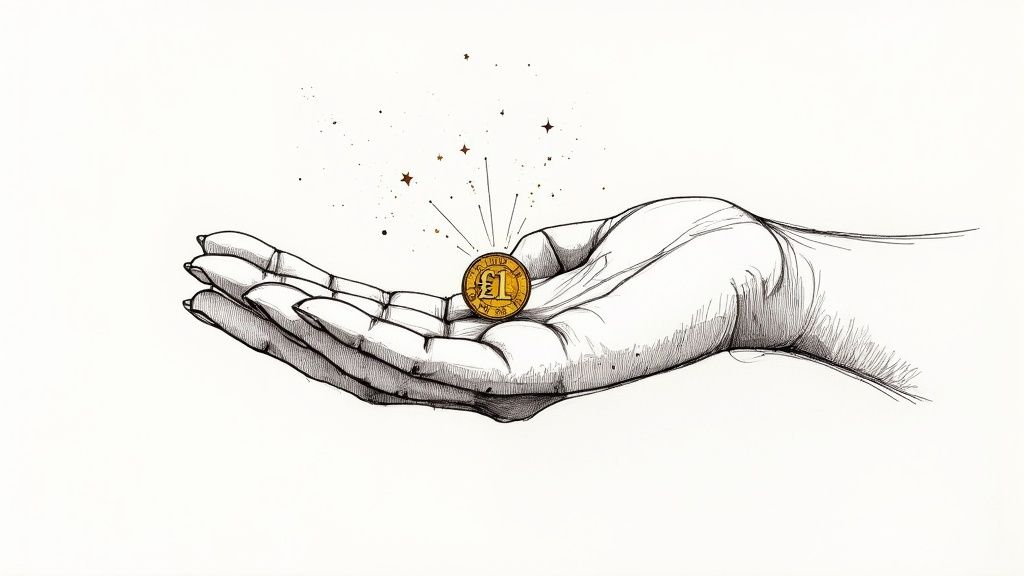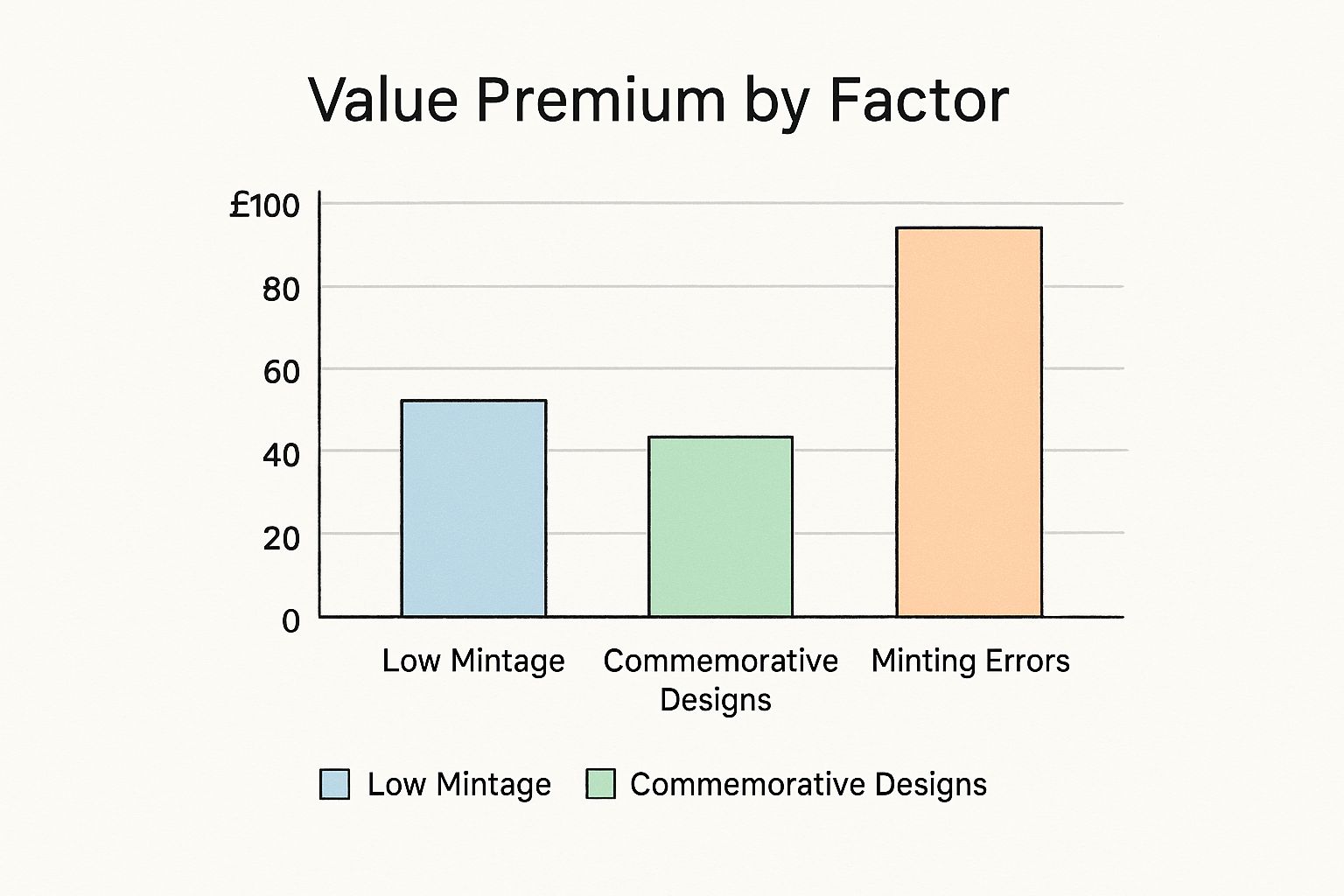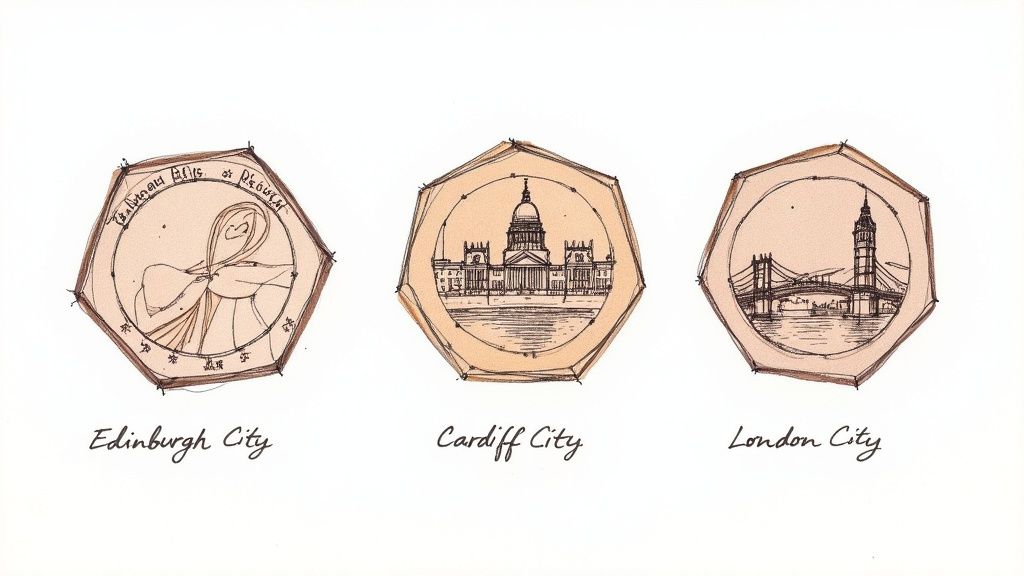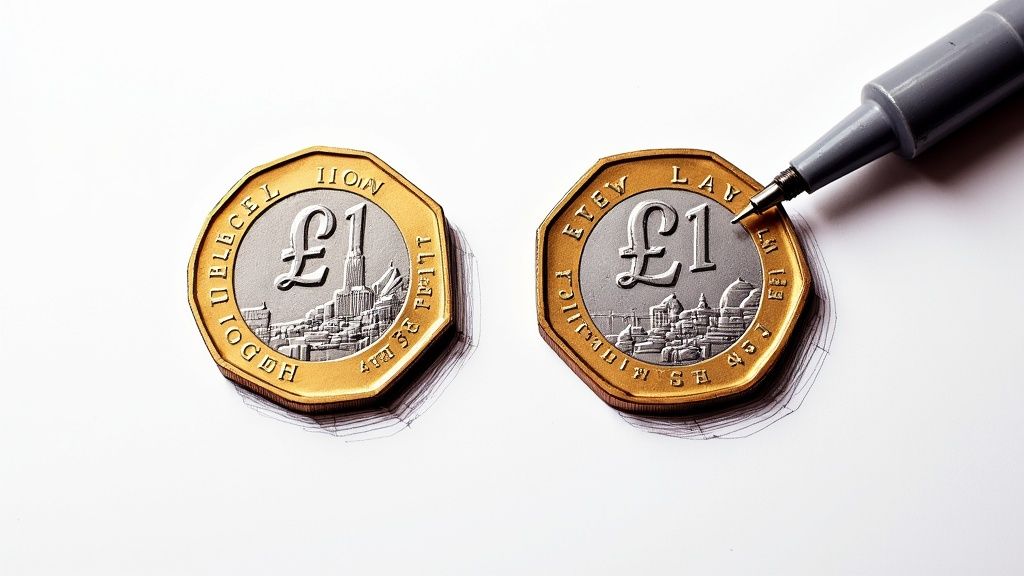Ever wondered if that handful of change rattling around in your pocket is worth more than face value? The answer is a resounding yes. Certain £1 coins are worth much more than money to the right person.
Rare designs, tiny production runs, and even mistakes during the minting process can transform a simple quid into a collector's dream. This guide is your starting point for spotting these hidden treasures.
Your Change Could Be Worth a Fortune

Next time you get some change, take a moment before you toss it into a jar. You might just be holding your ticket into the fascinating world of numismatics—the study and collection of currency. It turns out that some one pound coins are highly sought after by collectors, often fetching prices that dwarf their original value.
So, what makes an ordinary coin a valuable collectible? It usually boils down to a few key things that create scarcity. Think of it like a limited-edition art print; the fewer that were made, the more each one is worth to those who want it.
Key Factors Driving Coin Value
Several elements can make specific £1 coins worth money, and learning to spot them is the first step on your treasure hunt. The main drivers include:
- Low Mintage: This is the big one. The Royal Mint produces different quantities of each coin design every year. If a particular design had a very small production run, it's instantly rarer and more desirable.
- Commemorative Issues: Coins minted to celebrate special events, anniversaries, or national landmarks often have a lower mintage. Their unique story also makes them more appealing than the standard coins you see every day.
- Minting Errors: Mistakes happen, even at The Royal Mint. Coins with errors—like a misaligned strike or a dodgy inscription—are accidental rarities that can be exceptionally valuable to collectors.
A perfect modern example of scarcity driving value is the 2022 £1 coin. It holds a unique place in history as the final issue to feature the portrait of Queen Elizabeth II after her remarkable 70-year reign. With only 7.735 million released into circulation, its mintage is a fraction of the 100+ million often produced in previous years, making it a key piece for any collection. You can find more details about which £1 coins are worth collecting by exploring expert analyses.
This guide will set the stage, helping you identify the hidden gems that might already be waiting in your wallet or piggy bank.
What Makes a One Pound Coin Valuable
Ever looked at a £1 coin in your hand and wondered if it’s just a quid, or something more? You might be holding onto a piece that’s worth hundreds. The secret isn't some hidden magic; it's all about the coin's backstory and, crucially, its rarity. It’s a lot like a first-edition book being more sought-after than a later reprint. A coin's real value hinges on how many were made, the reason for its creation, and any little quirks it picked up along the way.
There are three main things that can turn a bit of pocket change into a collector’s dream. Getting your head around these is the first step to spotting the real treasures among your 1 pound coins worth money.
The Power of Low Mintage
The most straightforward reason a coin becomes valuable is its mintage. This is simply the total number of coins of a specific design that The Royal Mint produced in a particular year. Think of it like a limited-edition run of trainers; the fewer pairs they make, the more everyone wants them, and the higher the price climbs.
When a coin has a low mintage figure, it's rare by definition. If millions of a certain design are pumped into circulation, finding one is no big deal. But if only a couple of hundred thousand were ever minted, stumbling across one is a genuine find for any collector.
This simple rule of supply and demand is the bedrock of coin collecting. The lower the supply, the higher the potential value for anyone trying to build a complete set.
Commemorative Designs and Special Issues
Another big factor is what the coin was made for. Most coins are what we call "definitive" issues – the standard designs you see every day. But then you have commemorative coins, which are special editions struck to mark big national events, celebrate famous people, or honour important anniversaries.
Because they’re linked to a specific moment in time, these commemorative coins are usually made in smaller numbers and for a short period. Their unique designs and the stories they tell give them an extra layer of appeal that makes them far more desirable than their everyday cousins.
A coin is more than just currency; it's a miniature piece of history you can hold in your hand. Commemorative issues capture a specific chapter of our national story, and that historical significance is a huge part of what makes them valuable.
The Thrill of Minting Errors
Finally, we get to the most exciting – and unpredictable – reason a coin can be valuable: minting errors. These are little mistakes and imperfections that happen during the production process. While The Royal Mint has incredibly high standards, the odd mistake does slip through the net.
These aren't just random scuffs or scratches; they are unique variations that can make a coin truly one-of-a-kind. Some of the most hunted errors include:
- Mules: A fascinating mistake where a coin is struck with two different dies that were never meant to be paired, like the front of one coin design and the back of another.
- Off-Centre Strikes: This happens when the coin blank isn't perfectly aligned, causing the design to be stamped off-centre.
- Die Rotations: An error where the alignment between the front and back designs is off-kilter.
This chart shows how these different factors can stack up to add a serious premium to a coin's face value.

As you can see, a low mintage figure or a special commemorative design can certainly add value. But a confirmed minting error can send a coin's worth into a whole different league. If you're curious about the metals used in these coins, you can dive deeper into what UK coins are made of right here.
The Rarest £1 Coins to Look For

Right, this is the moment you’ve been waiting for – figuring out which specific coins might be hiding in your change jar. While lots of things can make 1 pound coins worth money, the number one rule is that low mintage is king. Think of this section as your treasure map, pointing you towards the heavy hitters of the coin world, from the old round pounds to the newer 12-sided ones.
We’re about to dive into the designs you need to spot, the all-important mintage figures, and what they’re actually fetching on the collector's market today. So, keep your eyes peeled because some of these are surprisingly easy to miss.
The Round Pound Rarities
The original round £1 coin officially left our pockets back in 2017, but many of its designs are still the most prized by collectors. These coins really represent a golden age for coin design, with fantastic series celebrating the four nations of the UK.
Among the true legends are the coins from the 'Capital Cities' series. These were released between 2010 and 2011, and each one features the official badge of a UK capital.
- 2011 Edinburgh City: With a tiny mintage of just 935,000, this is the undisputed rarest UK £1 coin ever to enter circulation. Its scarcity makes it the holy grail for round pound collectors, often selling for between £10-£15.
- 2011 Cardiff City: Not far behind is the Cardiff coin. Only 1,615,000 were ever minted, and its brilliant design and low numbers mean it can command prices of £8-£12.
- 2010 London City: The London design is a little more common, with 2,635,000 out there, but it’s still a key coin for any serious collection and is typically valued around £5-£8.
Other Notable Round Pounds
It’s not just about the capital cities, though. Several other series have some real gems tucked away. The 'Floral Emblems' and 'Bridges' sets both contain designs with impressively low mintages that make them hugely collectible.
Another one to watch for is the 2008 Royal Arms design. Now, this design was used many times over the years, but the 2008 version had a mintage of just 3,910,000. That makes it the rarest of its type and a fantastic find for anyone trying to complete the set.
A coin's value is often a direct reflection of its story and scarcity. A low mintage figure isn't just a number; it's proof that you're holding a genuine piece of numismatic history that few others possess.
Modern 12-Sided Coin Rarities
When the new bimetallic, 12-sided £1 coin was introduced in 2017, it opened up a whole new world for collectors. While most of these new coins have very high mintage figures, a few specific years and designs are already starting to show signs of becoming scarce.
Keep an eye out for the earliest dates, and always be on the lookout for coins that show obvious signs of minting errors. The standard 'Nations of the Crown' design is the one you'll see most, but even tiny variations can create real value.
The coin collecting world is always changing, and a coin's rarity can shift based on new releases and official announcements from The Royal Mint. For instance, the 2025 Bee £1 coin caused a massive stir when it was announced with a tiny mintage of just 170,000. But this was later updated to include another 8.84 million coins, completely changing its status. This story shows just how quickly things can change, and you can see more on how these events play out by watching expert coin collecting updates.
To make things easier, here’s a quick-reference table of the top coins to watch out for.
Top 5 Most Valuable UK £1 Coins
This table breaks down the top 5 rarest and most valuable pound coins based on their low mintage figures and what they’re currently fetching on the market.
| Coin Design | Year | Mintage Figure | Estimated Value Range |
|---|---|---|---|
| Edinburgh City | 2011 | 935,000 | £10 - £15 |
| Cardiff City | 2011 | 1,615,000 | £8 - £12 |
| London City | 2010 | 2,635,000 | £5 - £8 |
| Royal Arms | 2008 | 3,910,000 | £4 - £7 |
| Belfast City | 2010 | 6,205,000 | £3 - £5 |
These are the coins that every UK collector dreams of finding. Happy hunting
How to Spot Valuable Minting Errors

While a low mintage figure is the most common reason a coin becomes valuable, the most exciting finds are often the ones born from a simple mistake. A minting error can transform a totally standard coin into a fascinating, unique, and often quite valuable oddity.
Think of it like finding a postage stamp printed upside down. The imperfection is precisely what makes it a prize.
Inspecting your change for these little flaws requires a detective’s eye, but knowing what to look for makes it much easier. These aren't just random dings and scratches from being passed around; they are specific, repeatable mistakes that happened right on the production line at The Royal Mint.
Common Types of Minting Errors
Some errors crop up more often than others, but there are a few key types that collectors are always on the hunt for. Keep an eye out for these subtle clues that could mean you’ve found one of the 1 pound coins worth money.
- Mule Coins: This is probably the most famous type of error. A "mule" is a hybrid coin, struck using two dies that were never meant to be paired together. For example, using the Queen's head (the obverse) from one design with the tail's side (the reverse) of a completely different coin.
- Die Rotation Errors: On a normal coin, if you hold it upright and flip it over vertically, the design on the other side should also be perfectly upright. A die rotation error is when this alignment is off, meaning the Queen's head might be sideways or even completely upside down compared to the reverse.
- Off-Centre Strikes: This one is pretty self-explanatory. It happens when the blank coin isn't perfectly centred when it's struck by the dies. The result is a design that’s shifted to one side, often leaving a crescent-shaped part of the coin completely blank.
The real excitement in collecting comes from the unexpected. A rare design is a great find, but an error is a one-in-a-million accident frozen in metal—a true anomaly that was never meant to exist.
Famous £1 Coin Errors
One of the best-known modern errors involves the 2017 'Nations of the Crown' £1 coin. A small number of these brand-new 12-sided coins were accidentally struck on the old, round pound blanks.
This created a fantastic "mule" that combined the new design with the old shape. Unsurprisingly, these rare error coins have sold for hundreds of pounds.
Learning to identify these flaws can be incredibly rewarding. If you'd like to go deeper, you can discover valuable error coins and their hidden treasures in our more detailed guide. Spotting these tiny details is the real key to turning one pound into a significant collector's piece.
How to Grade and Sell Your Valuable Coins
Right, you’ve sifted through your change and found a coin that looks promising. This is where the real fun starts, but it’s also the point where you need to be extra careful. Getting from a potential treasure in your hand to actual money in your pocket means understanding its condition and knowing the right way to sell it.
After rarity, the single most important factor is the coin’s condition, or its grade. Think of it like a classic car; a model in showroom condition, straight off the factory line, will always be worth a fortune more than one that’s been rattling around for years. Even tiny, seemingly insignificant scuffs and scratches can slash the value of what might otherwise be one of the top 1 pound coins worth money.
Understanding Coin Condition
In the world of coin collecting, condition is king. We use a grading scale to describe a coin’s level of wear and tear, and while professional grading is a meticulous science, you can get a pretty good idea of your coin's state just by looking closely.
Here’s a quick rundown of the common grades you’ll encounter:
- Uncirculated (UNC): The coin looks brand new, as if it just left the mint. It has its original shine, or lustre, and every single detail is razor-sharp.
- Extremely Fine (EF): You can see some very light wear on the highest points of the design, but almost all the details are still crisp and clear.
- Very Fine (VF): The wear is more noticeable now, but still what you’d call moderate. The main details are clear, but some of the finer points are starting to look a bit soft.
To keep your coin in the best possible shape, always hold it by its edges and pop it into a protective holder. And whatever you do, never try to clean your coins. It might seem like a good idea, but cleaning causes microscopic scratches that permanently damage the surface and will absolutely kill its value to a collector. If you want to dive deeper, you can learn all about how to get coins graded by the pros.
Preparing Your Coin for Sale
Once you’ve got a handle on your coin's condition, it’s time to get it ready for potential buyers. Whether you're selling online or taking it to a dealer, presentation makes a huge difference.
Start by taking high-quality, well-lit photos. You want to capture both sides of the coin clearly, showing off as much detail as you can. Then, write a simple, honest description, making sure to include the year, the design, and any obvious errors or interesting features you’ve spotted.
It’s also crucial to remember the counterfeit problem. In the last few years of the old round £1 coin, fakes were everywhere. The Royal Mint’s own surveys in 2013 estimated that the counterfeit rate hit 3.04%, and some independent studies put the figure even higher. Because of this history, any genuine rare coins are looked at very closely, so proving authenticity is everything.
Choosing Where to Sell Your Coin
You’ve got a few different routes you can take when it comes to selling, and each has its pros and cons.
- Online Marketplaces (like eBay): Putting your coin online gives you a massive audience of collectors. You’re in control of the price, but you’ll be up against a lot of other sellers and will need to sort out all the packing and shipping yourself.
- Specialist Coin Dealers: A trustworthy dealer can look at your coin and give you a fair price on the spot. It’s a fast and safe way to sell, though the offer will likely be a bit less than what you might get at an auction, as they need to make a profit too.
- Auction Houses: If you think you’ve got an exceptionally rare or valuable coin, a specialist auction house is often your best bet. They have the contacts to attract serious collectors who are prepared to pay top-tier prices, but they will charge fees for their service.
To make sure you get the best return on your valuable £1 coins, it’s worth checking out a guide on the best way to sell collectibles to really maximise your profit. By grading your coin as best you can and picking the right place to sell, you can turn that lucky find into a fantastic sale.
Your Top Questions Answered
As you get deeper into the fascinating hobby of coin collecting, you're bound to have a few questions. This final section tackles some of the most common queries we hear, giving you the practical answers you need to hunt for those elusive 1 pound coins worth money with confidence.
Think of this as a quick-fire round to clear up any lingering doubts. From handling old currency to spotting fakes, these tips will set you up for the next stage of your collecting journey.
Are the Old Round Pound Coins Still Worth Anything?
Yes, absolutely! The old round £1 coins were taken out of circulation back in 2017, so you can no longer spend them in shops. But that doesn't mean they're worthless. In fact, for collectors, it's a completely different story.
Many of these older coins are now highly sought after. Some of the rarest and most valuable £1 coins out there are from the round pound series, like the highly prized 2011 Edinburgh and Cardiff City designs. Their incredibly low mintage figures make them must-haves for any serious collector. So, before you even think about taking them to the bank, always check them against a list of rare designs.
Never assume an old coin is just face value. Its real worth is determined by its rarity and how much collectors want it, not its status as legal tender.
How Can I Tell If a Rare £1 Coin Is Genuine?
Learning to spot a genuine coin is a crucial skill, especially when you're dealing with valuable pieces. A great starting point is to simply compare your coin to a picture of a known genuine one online. Look closely at the quality of the lettering, the sharpness of the design, and the overall finish.
The modern 12-sided coins have some clever security features built right in:
- A hidden hologram below the Queen's portrait that switches between a '£' symbol and a '1' when you tilt it.
- Tiny micro-lettering on the inner rim of both sides of the coin.
- The two-metal (bimetallic) construction should look clean and seamless.
For the older round pounds, pay attention to the edge inscription – it should be clear and well-defined. If you're ever in doubt, particularly before spending a lot of money, the safest bet is always to get an expert opinion from a reputable coin dealer.
Should I Clean My Coins to Increase Their Value?
This is one of the most important questions in collecting, and the answer is a very firm no. It's a classic rookie mistake that can permanently destroy a coin’s value. Cleaning a coin, no matter how carefully you do it, leaves behind microscopic scratches (known as "hairlines") and strips off its natural patina—the subtle toning that develops over time.
Collectors actually prize that original surface. Any hint of cleaning can knock a coin's grade down and slash its worth. The best practice is simple: always handle coins by their edges and keep them safe in protective, acid-free holders to preserve their condition.
Where Is the Best Place to Find Rare £1 Coins?
The thrill is in the hunt, and the best place to start is right in your own pocket! Checking your daily change is a free and exciting way to kick off your collection and train your eye.
If you want to see more coins, you can often ask to swap notes for bags of coins at your local bank or post office. As you get more serious and start hunting for specific designs, you can explore other avenues:
- Online marketplaces like eBay.
- Specialist coin dealers and shops.
- Local and national coin fairs.
But honestly, starting with the coins you find in circulation is the perfect way to learn the ropes without spending a penny more than face value.
At Cavalier Coins Ltd, we're passionate about helping both new and experienced numismatists build collections they can be proud of. Explore our huge selection of rare and fascinating coins from the UK and around the world today. Visit us at https://www.cavaliercoins.com to find your next treasure.

